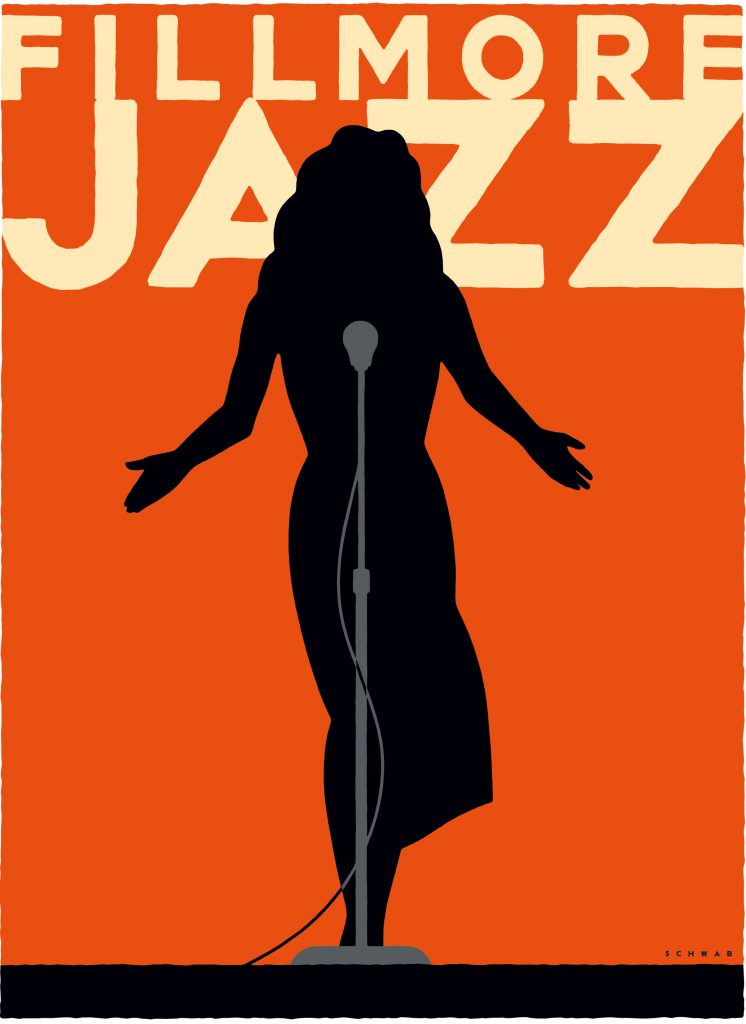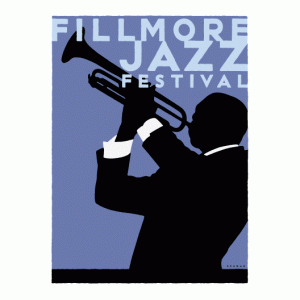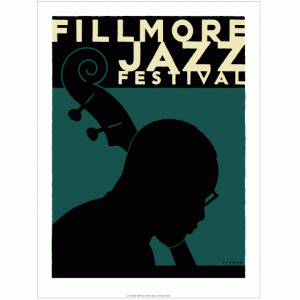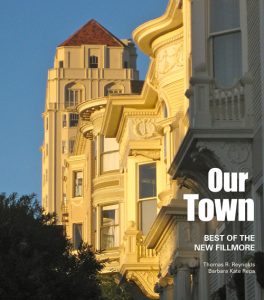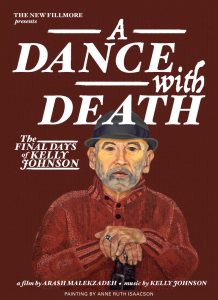POSTER ARTIST | MICHAEL SCHWAB
You’ve seen them all across San Francisco in recent weeks — striking posters featuring a wavy-haired female vocalist silhouetted against a fiery orange background. The image for this year’s Fillmore Jazz Festival poster and street banners was created by Marin artist Michael Schwab, one of the country’s leading graphic artists. His dynamic posters and logos for the Golden Gate National Parks, Major League Baseball, America’s Cup, Amtrak, Robert Mondavi, Peet’s Coffee, the San Francisco Opera and Nike, among many others, are icons of our time. Schwab talked about creating his third Fillmore jazz poster with ARThound editor Geneva Anderson.
What makes a really effective poster? And why are so many posters today so bad?
Simplicity. There’s way too much visual noise out there. Graphic messages are conveyed much more effectively when the design is simple, bold and efficient.
You’ve had a long involvement with the Fillmore Jazz Festival. What is it about jazz that lends itself to visual expression?
I love all kinds of music, but jazz in particular inspires me. I love this project because I’ve had complete freedom to do whatever I want. The bass player I created eight years ago was my first Fillmore jazz poster and I envisioned him as a Ray Brown-like bass player. If you’re driving down the street, you’ve only got a second or two to get the message, so I wanted to evoke the romance and history of jazz in the Fillmore. Four years later they called me again. At the time I was really into Miles Davis and was playing Ascenseur pour l’échafaud, his soundtrack for the Louis Malle film, a lot. I made a Miles Davis-esque horn player. I wanted a really cool color so I went with a deep blue that evokes that late evening jazz atmosphere that’s so special on Fillmore. Now, four years later, I realize I’ve been slowly creating my own jazz band. It was time for a singer — and a woman.
What was your conception for this year’s poster?
I was inspired by the great romance of Billie Holiday. Initially I had just the singer in silhouette and then I realized that she needed a microphone, which was the last element I added. That old-fashioned microphone, which harkens back to the 1940s and ’50s, really pulled it all together. It often happens that way — that adding something relatively small becomes very important.
What types of source materials do you normally use? Also, since this year’s festival is all about women of jazz, who do you listen to for inspiration?
When appropriate, I work with models — human or otherwise. I pose and shoot my own photos. In this case, there was a model I’d used a while back and I was able to piece together a few Polaroids and work from that. I wanted the hands to be special, and they’re actually my wife Kathryn’s hands. As for female vocalists, it doesn’t get any better for me than early Diana Krall.
And what about your bold colors — how did you decide what to go with?
Not all jazz is blue and cool. This time I wanted a color that complemented the other two posters and this bold orange red represents the hot side of jazz. The flat color tones make the images, which are already abstracted by the silhouette, seem mysterious, almost two-dimensional. I wanted all three posters to become a triptych and to work well together.
Your font is very expressive. What goes into its style, size and positioning?
It’s a hand-lettered, custom font that I created. I use it for most of my projects because it has a retro-American personality. As for the size and positioning, that’s all tweaked carefully after the initial image has been created.
There is a nostalgic aspect to these images as well, harkening back to old woodcuts.
Several of my heroes were Japanese woodcut artists and old European poster artists — Henri de Toulouse-Lautrec and A.M. Cassandre from France, Ludwig Holwein from Germany and the Beggarstaff Brothers from England. There’s a lot of graceful movement as well as drama in those works. I was never very painterly in my style. I enjoy working with big bold shapes and challenge myself to get a message across using as few shapes and colors as possible. I’ll keep working with the colors, combining them and fine-tuning, until they’re right to me. Then it’s a matter of getting the image and text to work together effectively. I really enjoy these jazz posters because I can get very dramatic with them. Speaking of old-school, I begin each project with a pencil and paper and use a Rapidograph pen and ink to create the line work. In the end, though, it becomes a digital file so I’m speaking the same language as everyone else.
What’s the first poster you made and what are a few of your personal favorites?
My first professional poster was for Levi’s, back in 1975. I’ve been a graphic artist now for almost 40 years and I’ve had a few home runs. The images for the Golden Gate parks and Amtrak are favorites. I feel very good about some of the logos—the Robert Mondavi corporate logo, Pebble Beach, David Sedaris. I love all of the Fillmore Jazz and San Francisco Opera posters. Frankly, my current favorite is always the one I’m working on. It becomes my child.
What are you working on now?
I just finished the logo design for the San Francisco Bay Area Super Bowl 50 Host Committee for 2016. It’s a gold seal design — a silhouette of a football and the Golden Gate Bridge.
Michael Schwab’s new Fillmore jazz poster can be purchased at the festival. His posters for the 2006 and 2010 festivals are available at michaelschwab.com.
Filed under: Art & Design


